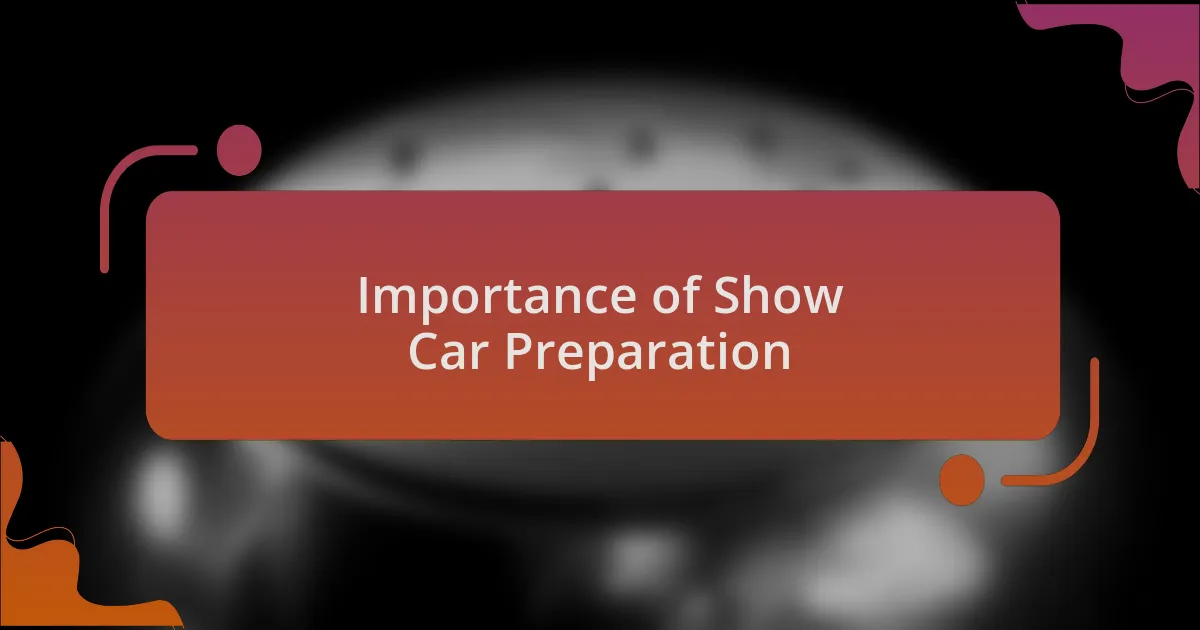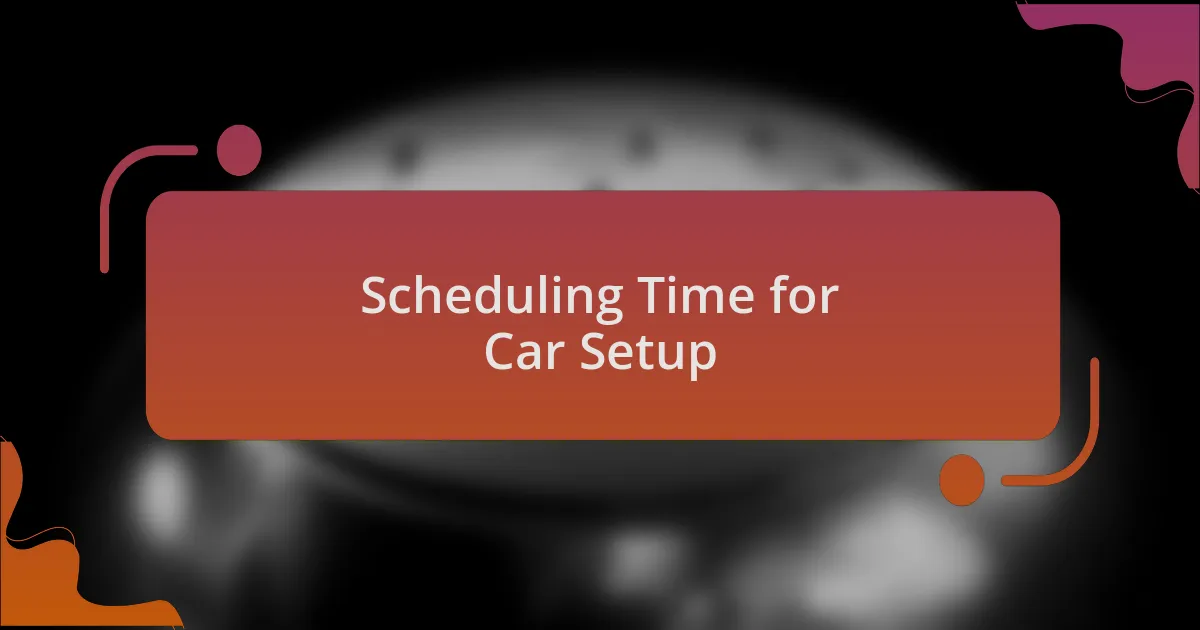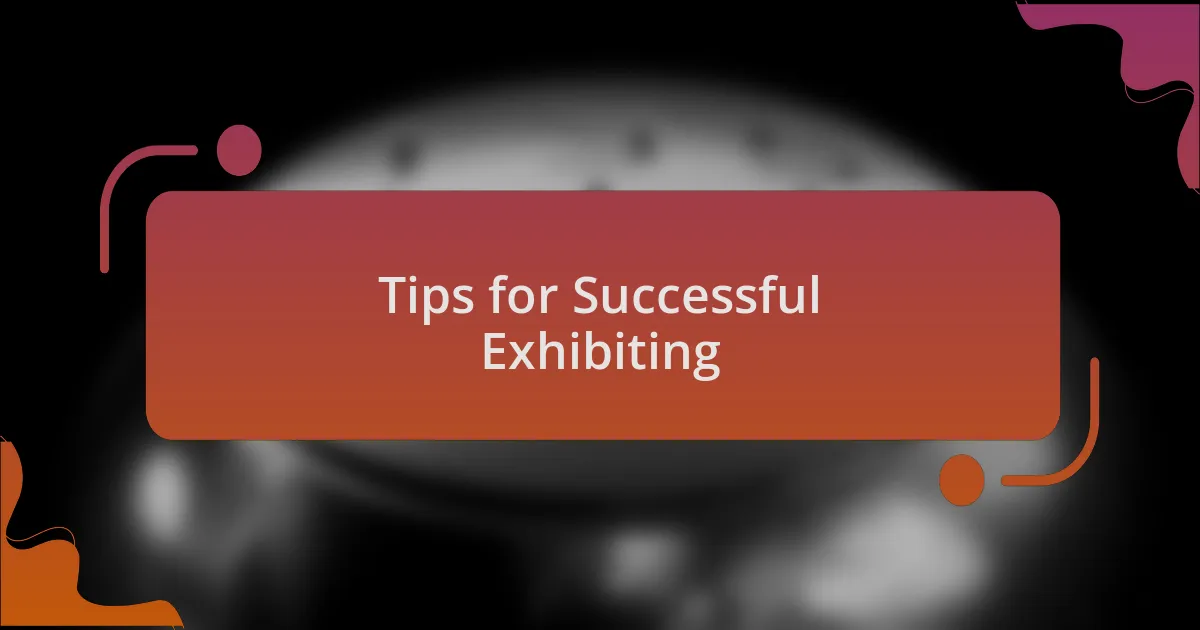Key takeaways:
- Effective show car logistics require meticulous planning, contingency strategies, and open communication with transport teams.
- Preparation includes not only detailing the car but also creating an engaging display and a welcoming atmosphere to connect with attendees.
- Scheduling ample time for car setup and ensuring on-site requirements are met can significantly enhance the show experience.
- Personal experiences highlight the necessity of decision-making, solid checklists, and careful transport to ensure a successful exhibition.

Overview of Show Car Logistics
When it comes to show car logistics, I’ve learned that planning is everything. For instance, during one memorable expo, I felt the weight of organizing transport and accommodations for multiple vehicles. It’s a dance of timing and precision; each detail can make or break the experience.
I remember a particularly challenging year when unexpected weather conditions threatened my plans. Suddenly, I found myself reassessing transportation routes and ensuring my car was safely covered. Have you ever had to pivot on short notice like that? It’s in those moments that I realized how crucial it is to have contingency plans in place.
Effective show car logistics isn’t just about getting the cars to the venue; it’s also about the connections made along the way. Each journey holds a story—like the time I bonded with a fellow enthusiast over a shared love for classic engines during a long haul. It’s those experiences that turn logistics from a mere task into a passionate part of the car show journey.

Importance of Show Car Preparation
Preparation for a show car is more than just a checklist; it’s about creating an experience that highlights the passion and craftsmanship behind each vehicle. I once spent countless hours detailing a classic Mustang, ensuring every inch gleamed under the showroom lights. That moment in the spotlight validated the time and effort I invested and showed just how essential preparation is to impress judges and enthusiasts alike.
I’ve often wondered: What makes a car stand out at a show? I believe it’s the attention to detail that sets it apart from the rest. During one particular event, I took a risk by enhancing my car’s presentation with a unique theme. The response was overwhelming, reminding me that thorough preparation goes beyond mechanics; it encompasses creativity and engagement with the audience.
Ultimately, investing time in show car preparation can turn an ordinary display into an extraordinary one. I recall the thrill of unveiling a meticulously restored vintage car, paired with a well-researched backstory that captivated everyone. Those moments fuel my passion and underscore that preparation is not just a necessity; it’s what breathes life into the cars we cherish.

Key Aspects of Car Transport
Transporting a show car is a meticulous process that requires careful coordination. I still remember the tension I felt when arranging transportation for a prized classic. The key is to ensure that your vehicle is protected from any damage, so I always opt for enclosed trailers whenever possible. It’s amazing how much peace of mind that choice brings.
Timing is another crucial aspect of car transport that can’t be overlooked. Once, I faced a last-minute scheduling conflict that threatened to leave my car without enough time to arrive at the venue. Planning ahead allowed me to work with a reliable transport company that understood the urgency and delicacy of handling show cars. Have you considered how scheduling impacts the overall success of your show? I’ve found that being proactive not only ensures a smooth arrival but also allows time to address any unexpected issues that may arise.
Lastly, communication with the transport team is vital in this process. I’ve learned this the hard way after a previous experience where a lack of updates caused me anxiety. By establishing clear lines of communication and sharing specific instructions, I’ve fostered a trust that gives me confidence while my car is in transit. This aspect of logistics, often overlooked, can mean the difference between a stressful transport experience and one that allows you to focus on your show preparations.

Scheduling Time for Car Setup
Scheduling time for car setup is essential to a successful show experience. I always allocate more time than I think I’ll need, which has saved me on numerous occasions. I remember one particular event where I underestimated setup time. Rushing left me frazzled and, worse, I missed a few details that I would have liked to perfect before the judges arrived.
In my experience, I like to check the event schedule and set my car up at least a few hours before the gates open. This buffer allows me to tackle any last-minute adjustments and ensures I’m not rushed. Have you ever felt that panic creeping in when you realize you’re running behind? I can definitely relate. By allowing extra time, I’ve turned what could be a stressful experience into time for enjoying the atmosphere and connecting with fellow enthusiasts.
Additionally, I make sure to factor in time for cleaning and polishing. It may seem trivial, but those final touches can truly make a difference in how my car is perceived. There was a show where I was able to enjoy that final hour to buff out the shine rather than just scrambling to set up. It’s moments like that, where I can step back and admire my work, that make all the effort worthwhile.

Managing On-Site Requirements
One of the most crucial aspects of managing on-site requirements is ensuring I have the right tools and supplies ready. I’ve learned the hard way that forgetting something as simple as a microfiber cloth can lead to unnecessary stress. Just imagine standing there, with your meticulously polished car, only to realize you can’t clean that smudge right before judging. It’s those little details that can make a big difference.
I also keep communication lines open with the event staff. Having a direct contact person can help in case of unexpected issues, like needing extra space or tools. I remember a time when I had to move my display a few feet over due to safety concerns. Thankfully, I had a great rapport with the staff, and they accommodated me quickly. If you ever find yourself in a pinch, don’t hesitate to reach out; you’d be surprised at how willing people are to help when you’re polite and proactive.
Lastly, it’s important to create a comfortable space around my vehicle. I usually bring along some folding chairs and refreshments. This setup allows me to relax between interactions and delve into conversations with fellow car enthusiasts. Have you ever noticed how inviting a space can draw people in? I’ve found that a welcoming atmosphere makes it easier to share stories and build connections, enriching the entire show experience.

Tips for Successful Exhibiting
One of the best strategies I’ve found for successful exhibiting is to set clear goals before the event. Ask yourself, what do you want to achieve? Are you there to network, sell parts, or simply share your passion for vintage cars? I recall a show where my aim was to connect with potential buyers. By focusing on that goal, I tailored my conversations and materials specifically for them, resulting in numerous fruitful discussions.
Don’t underestimate the power of an engaging display. It’s not just about the car; it’s about creating an experience. During one expo, I incorporated a backdrop that told the story of my vehicle’s restoration. This drawn-in interest led to conversations that became moments of joy and nostalgia. When viewers see a narrative, they’re more likely to connect on a deeper level—after all, who doesn’t love a good story?
Preparation doesn’t stop at the car itself; your appearance matters too. I always make it a point to dress appropriately—something comfortable yet stylish, showcasing my passion for the classic car culture. Remember a time when you noticed someone who truly embodies what they love? That connection can lead to trust, sparking curiosity about your vehicle and ultimately enhancing the overall exhibition experience.

Personal Experiences in Car Logistics
When it comes to logistics, I once faced a real challenge transporting my vintage car to a show a hundred miles away. I remember standing in my garage, weighing whether to drive it or trailer it. In the end, I opted for the trailer—better safe than sorry, right? Making that decision eased my mind, knowing I’d protect the car from potential road risks.
There’s something incredibly rewarding about loading up your prized vehicle for an event. I still vividly recall the adrenaline rush when I secured the straps, ensuring everything was snug and safe for transport. Each click of the ratchet strap felt like a commitment to safeguard my labor of love. Have you ever had that moment of anxiety before a big reveal, wondering if everything will come together smoothly? Trust me, that preparation is worth every ounce of effort.
Additionally, I’ve learned the importance of a solid checklist during the logistics process. Once, I forgot to bring a crucial set of tools and the required paperwork for entry. It was quite the lesson! Now, I meticulously ensure I have everything packed, from my car cover to display materials. It might seem tedious, but every time I check off an item, I feel a sense of accomplishment that sets the tone for a successful show.